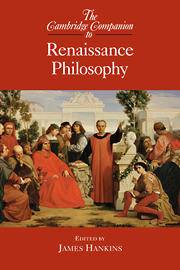Book contents
- Frontmatter
- 1 Introduction
- Part I Continuity and Revival
- Part II Toward Modern Philosophy
- 9 Nicholas of Cusa and modern philosophy
- 10 Lorenzo Valla and the rise of humanist dialectic
- 11 The immortality of the soul
- 12 Philosophy and the crisis of religion
- 13 Hispanic scholastic philosophy
- 14 New visions of the cosmos
- 15 Organizations of knowledge
- 16 Humanistic and scholastic ethics
- 17 The problem of the prince
- 18 The significance of Renaissance philosophy
- Appendix: Brief biographies of Renaissance philosophers
- Bibliography
- Index
14 - New visions of the cosmos
from Part II - Toward Modern Philosophy
Published online by Cambridge University Press: 28 November 2007
- Frontmatter
- 1 Introduction
- Part I Continuity and Revival
- Part II Toward Modern Philosophy
- 9 Nicholas of Cusa and modern philosophy
- 10 Lorenzo Valla and the rise of humanist dialectic
- 11 The immortality of the soul
- 12 Philosophy and the crisis of religion
- 13 Hispanic scholastic philosophy
- 14 New visions of the cosmos
- 15 Organizations of knowledge
- 16 Humanistic and scholastic ethics
- 17 The problem of the prince
- 18 The significance of Renaissance philosophy
- Appendix: Brief biographies of Renaissance philosophers
- Bibliography
- Index
Summary
The Aristotelian representation of the universe inherited from the Middle Ages remained dominant into the second half of the sixteenth century. It is true that the fifteenth-century revival of Platonism spearheaded by Marsilio Ficino as well as the more diffuse renaissance of Stoicism had undermined certain aspects of Aristotelian cosmology, such as the nature of the heavens as quintessence, the solid and impenetrable character of the celestial spheres, and the principle of the motion of celestial bodies. Nevertheless, even these alternative philosophies all embraced the key features of the Aristotelian universe - the finiteness and sphericity of the cosmos, the heterogeneity of and hierarchy between the supralunar and sublunar worlds, and the Earth as central and unmoving - and Aristotelianism thus retained an unthreatened hegemony, especially in the universities.
This was in spite of the publication in 1543 of Copernicus’ Six Books on the Revolutions of the Celestial Spheres (De revolutionibus orbium coelestium libri sex), which proposed a new calculus of planetary motion based on several new “hypotheses” (among them, heliocentrism and a mobile Earth). It also proposed a new cosmology consonant with these hypotheses and the immobility of the ultimate sphere of the universe (and therefore of the world as totality, as well). At the time, the dominant response to Copernicus’ work treated it solely as an astronomical hypothesis and ignored its cosmological implications. Consequently, at least until the first adherents of Copernicus’ cosmology (such as Michael Maestlin, implicitly, and Thomas Digges, explicitly) began to publish in the 1570s, the Aristotelian representation of the universe continued unchallenged.
- Type
- Chapter
- Information
- The Cambridge Companion to Renaissance Philosophy , pp. 270 - 286Publisher: Cambridge University PressPrint publication year: 2007
- 7
- Cited by

